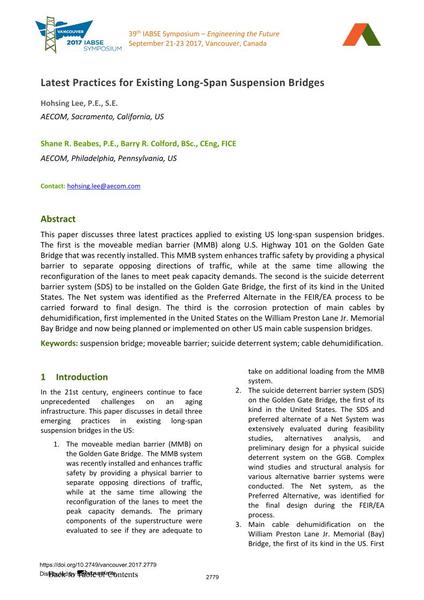Latest Practices for Existing Long-Span Suspension Bridges

|
|
|||||||||||
Détails bibliographiques
| Auteur(s): |
Hohsing Lee
(AECOM, Sacramento, California, US)
Shane R. Beabes (AECOM, Philadelphia, Pennsylvania, US) Barry R. Colford (AECOM, Philadelphia, Pennsylvania, US) |
||||
|---|---|---|---|---|---|
| Médium: | papier de conférence | ||||
| Langue(s): | anglais | ||||
| Conférence: | IABSE Symposium: Engineering the Future, Vancouver, Canada, 21-23 September 2017 | ||||
| Publié dans: | IABSE Symposium Vancouver 2017 | ||||
|
|||||
| Page(s): | 2779-2785 | ||||
| Nombre total de pages (du PDF): | 7 | ||||
| Année: | 2017 | ||||
| DOI: | 10.2749/vancouver.2017.2779 | ||||
| Abstrait: |
This paper discusses three latest practices applied to existing US long-span suspension bridges. The first is the moveable median barrier (MMB) along U.S. Highway 101 on the Golden Gate Bridge that was recently installed. This MMB system enhances traffic safety by providing a physical barrier to separate opposing directions of traffic, while at the same time allowing the reconfiguration of the lanes to meet peak capacity demands. The second is the suicide deterrent barrier system (SDS) to be installed on the Golden Gate Bridge, the first of its kind in the United States. The Net system was identified as the Preferred Alternate in the FEIR/EA process to be carried forward to final design. The third is the corrosion protection of main cables by dehumidification, first implemented in the United States on the William Preston Lane Jr. Memorial Bay Bridge and now being planned or implemented on other US main cable suspension bridges. |
||||
| Mots-clé: |
pont suspendu
|
||||

